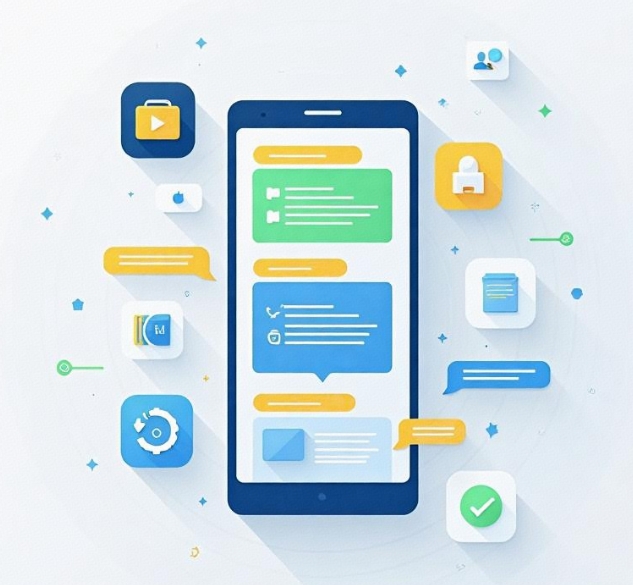Steps for Mini-Program Development: From Requirement Analysis to Launch and Operation
- latest articles
- 1.DApp Development & Customization: Merging Diverse Market Needs with User Experience 2.Analysis of the Core Technical System in DApp Project Development 3.How to achieve cross-chain interoperability in Web3 projects? 4.How does the tokenization of points reconstruct the e-commerce ecosystem? 5.How to Set and Track Data Metrics for a Points Mall? 6.What is DApp Development? Core Concepts and Technical Analysis 7.Inventory of commonly used Web3 development tools and usage tips 8.Development of a Distribution System Integrated with Social E-commerce 9.Six Key Steps for Businesses to Build a Points Mall System 10.What is DApp Development? A Comprehensive Guide from Concept to Implementation
- Popular Articles
- 1.Future Trends and Technology Predictions for APP Development in 2025 2.Analysis of the DeFi Ecosystem: How Developers Can Participate in Decentralized Finance Innovation 3.From Zero to One: How PI Mall Revolutionizes the Traditional E-commerce Model 4.DAPP Development | Best Practices for Professional Customization and Rapid Launch 5.Recommended by the Web3 developer community: the most noteworthy forums and resources 6.From Cloud Computing to Computing Power Leasing: Building a Flexible and Scalable Computing Resource Platform 7.How to Develop a Successful Douyin Mini Program: Technical Architecture and Best Practices 8.Shared Bike System APP: The Convenient Choice in the Era of Smart Travel 9.How to Create a Successful Dating App: From Needs Analysis to User Experience Design 10.From Design to Development: The Complete Process of Bringing an APP Idea to Life
With the rapid development of the mobile internet, mini-programs, as lightweight applications, have gradually become the choice for many enterprises and individual developers. The advantages of mini-programs lie in their quick startup, no need for download and installation, and cross-platform operation, which have led to their widespread promotion in commercial applications. However, developing a mini-program is not an overnight task; it requires a series of steps and processes, including requirements analysis, functional design, development implementation, testing, launch, and operation. This article will detail the steps of mini-program development, covering the entire process from requirements analysis to launch and operation.
I. Requirements Analysis: Clarifying Goals and Functions
Requirements analysis is the first step in any software development process, and mini-program development is no exception. Without clear requirements analysis, issues such as deviation in direction and unreasonable functional design may arise during development, ultimately affecting the project's quality and effectiveness. The goal of requirements analysis is to help the development team accurately understand user needs, market competition, and the problems the mini-program aims to solve.
Identify the Target User Group
In the requirements analysis phase, it is first necessary to identify the target users of the mini-program. Different user groups have different needs and usage habits. For example, for e-commerce mini-programs, the target users may be consumers who focus on product prices and logistics information; for educational mini-programs, the target users may be students and parents who prioritize learning progress and interaction. Understanding user needs is the foundation for designing the mini-program's functions.
Analyze Market Demand
Secondly, it is necessary to analyze the market to understand existing competing products and potential market gaps. Analyzing the functions, strengths, and weaknesses of similar mini-programs can provide references for designing your own mini-program. By analyzing market demand, the development team can determine which functions are essential, which are optional, and which can provide users with a unique experience.
Define Core Functions
One of the core tasks of requirements analysis is to clarify the mini-program's core functions. For example, if it is an e-commerce mini-program, it may need to include functions such as product display, shopping cart, order management, and payment; if it is a social mini-program, it may need functions like friend management, social interaction, and message push. Defining the core functions provides a clear direction for subsequent functional design and development.
II. Functional Design: User Experience as the Core
Functional design is one of the core aspects of mini-program development, directly impacting the user experience. A well-designed functionality ensures that user needs are fully met while enhancing the mini-program's convenience and usability.
Interface Design (UI Design)
Interface design is the first step in mini-program development, determining how users interact with the mini-program. A clear, concise, and aesthetically pleasing interface design enhances the user experience and increases the mini-program's appeal. When designing the interface, principles such as simplicity, usability, and consistency should be followed, while also considering adaptability to different devices.
For example, when designing a WeChat mini-program, it needs to be compatible with different phone models and adapt to various screen sizes. Therefore, designers must consider these details during the design phase to ensure a good user experience regardless of the device used.
Interaction Design (UX Design)
In addition to interface design, interaction design is also a crucial part of mini-program development. The goal of interaction design is to enable users to complete their tasks easily. User operation flows should be simple and intuitive, avoiding complex steps and minimizing cognitive load. Good interaction design enhances user satisfaction and makes the mini-program easier to use.
Functional Module Design
After defining the core functions in the requirements analysis, the next step is to design these functions in detail. This includes the specific implementation methods, data flow, and operation processes. For each functional module, clear flowcharts or functional diagrams should be designed to help developers understand and accurately implement them.
III. Development Implementation: Technical Realization and Coding
After completing requirements analysis and functional design, the next stage is the development implementation of the mini-program. The development team needs to transform the design documents into executable program code. In this phase, developers are responsible for the specific coding work of the mini-program.
Select Development Tools and Platforms
Mini-program development typically uses specialized development tools and platforms. For example, WeChat mini-programs can be developed using the official WeChat Developer Tools, which support development, debugging, and publishing. When selecting development tools, factors such as functionality support, development efficiency, and compatibility with other technology stacks should be considered.
Frontend Development
Frontend development for mini-programs mainly involves interface presentation and user interaction. Technologies such as HTML, CSS, and JavaScript are typically used to implement the mini-program's pages and interactive functions. Developers need to gradually implement each page of the mini-program based on the design drafts and perform necessary debugging.
Backend Development
Backend development handles the mini-program's business logic, data storage, and interface services. The backend typically requires setting up a database to store user data, order information, etc. Backend development also involves creating API interfaces for the frontend to call. During this process, developers must ensure the stability, security, and scalability of the backend system.
Database Design and Interface Development
Database design is a crucial part of backend development. Based on the mini-program's functional design, the structure of database tables must be planned, and corresponding data storage and operation logic must be designed. Additionally, API interfaces for communication with the frontend need to be developed to ensure smooth data interaction between the frontend and backend.
IV. Testing: Ensuring Quality and Stability
Testing is an indispensable part of the mini-program development process. Only through thorough testing can the quality and stability of the mini-program be ensured. Testing mainly includes unit testing, integration testing, and system testing.
Functional Testing
Functional testing primarily verifies whether the mini-program has implemented all functions as expected. Testers need to check each functional module of the mini-program to ensure there are no bugs or abnormalities.
Performance Testing
Performance testing mainly checks whether the mini-program can maintain good response speed and stability under high concurrency and heavy traffic. Performance testing typically involves simulating a large number of user visits to examine the mini-program's performance under high load.
Compatibility Testing
Compatibility testing mainly checks whether the mini-program can operate normally on different devices, operating systems, and network environments. The mini-program needs to be compatible with various phone screen sizes and operating system versions to ensure a consistent user experience for all users.
Security Testing
Security testing primarily checks for security vulnerabilities in the mini-program to prevent issues such as data leaks and theft of user information. Developers need to conduct a comprehensive security audit of the mini-program to ensure no security risks arise after launch.
V. Launch and Operation: From Release to Optimization
After the mini-program has been tested and all bugs fixed, the next step is the launch. Once launched, the mini-program will be officially available to the public, and users can access it through platforms like WeChat.
Launch Preparation
Before launch, a series of preparations need to be made. This includes uploading the mini-program to the relevant platform (e.g., WeChat, Alipay), submitting it for review, and filling in relevant information. Documentation and user support services should also be prepared to address user feedback promptly after launch.
Operation and Promotion
After launch, the mini-program needs to be promoted and operated. Promotion can be done through social media, offline events, advertising, etc., to increase the mini-program's visibility and user engagement. Meanwhile, the operation team needs to regularly analyze usage data, optimize functions, and enhance the user experience.
Continuous Updates and Optimization
The operation of a mini-program does not mean the end but is an ongoing process. During operation, user feedback must be continuously collected, data analyzed, and functions updated and optimized based on market demands. Through continuous iteration, the mini-program can stay up-to-date and remain competitive.
Conclusion
The development process of a mini-program is complex and detailed, involving multiple stages such as requirements analysis, functional design, development implementation, testing, launch, and operation. Each step requires close collaboration and coordination among team members to ensure the final mini-program meets user needs and stands out in the market. Through continuous optimization and updates, the mini-program can achieve long-term operation and commercial value.
-

How to Increase User Stickiness and Activity Through Mini Program Development
With the development of the internet and mobile internet, mini-programs, as an e···
-

How can mini-program development assist in corporate marketing and e-commerce transformation?
In today's rapidly evolving mobile internet landscape, corporate marketing and e···
-

Offline Functionality Design and Data Synchronization in Mini-Program Development
With the rapid development of mobile internet, mini-programs, as a lightweight a···

 Blockchain
Blockchain












